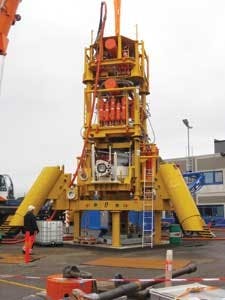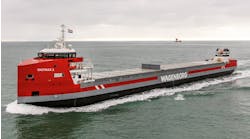Stephen Hall
Stork Technical Services UK Ltd.
Vessels are a crucial part of the offshore oil and gas industry and provide a means for delivering vital services such as IRM (inspection, repair, and maintenance). Operating across the world in waters of varying salinity and temperature means vessels are highly susceptible to critical corrosion damage. For example, localized pitting can occur on steel or aluminium hull plates and result in the complete penetration of the hull below the waterline. This can render a vessel unseaworthy, leading it to be dry docked for unscheduled and costly maintenance.
Cathodic protection (CP) is a cost-effective and efficient corrosion mitigation solution and is central to almost every hull design. With accurate datasets, it is possible to predict the most likely future state of a hull's integrity, which helps operators effectively plan preventative action. However, a number of factors impact the effectiveness of a CP system, such as structural components, surface area, and existing coatings; and as these variables can change over time, it is possible for premature corrosion to occur.
A recent example of this is when Stork Technical Services UK Ltd. was approached by a major subsea services provider to investigate the premature depletion of sacrificial anodes on the hull of one of its survey vessels. A remedial design and installation plan was required within the week the vessel was dry docked for ongoing maintenance.
CP system development
A CP system comprises an anti-corrosion coating and either sacrificial anodes, most commonly used subsea, or impressed current anodes with a power unit to drive them. The aim of a CP system is to polarize a structure as quickly as possible and maintain the optimum protection for the design life.
To develop an effective CP system for a hull, information and data on factors such as the sea chests and operating environment has to be analyzed and related to certified industry design standards and previous project experience.
The condition of the surface area and type of existing coatings must also be determined to calculate the required mass of the anodes, the electrical current output by the total anodes present, and from each individual anode. Using this information and recommended current density values, it is then possible to develop an effective CP system based on the mass and electrical current demands.
CP monitoring system
Once designed and installed, planned inspections to gather datasets are required to determine if the system has achieved its initial goal of continuously protecting the hull. For sacrificial CP systems used below the waterline, an ROV is equipped with a multi-electrode system to measure potentials and current densities around the hull. Both the potential and current density readings are used in detailed data analysis. Anode output currents can be calculated from the readings using an appropriate mathematical model such as a modified Dwight's equation or McCoy's formulae. Since the ROV survey system uses a traceable calibration source, a historic trend analysis can also be evaluated accurately and used to make meaningful predictions. All of the gathered data, along with the original design details, allow for an accurate assessment of a hull's corrosion risk and helps in planning preventative maintenance.
For vessels without ROV capabilities, an electrochemical potential survey around the hull can be carried out using a "dip-cell" method. This utilizes a standard silver/silver-chloride reference electrode which is placed close to the hull in various locations at varying depths, and is measured with a high input impedance voltmeter. While this method is effective, it can only be used to identify CP potentials.
Monitoring the effectiveness of an impressed current cathodic protection (ICCP) system is more complex. In addition to monitoring the anodes, it is also essential to test the power units, stationary reference cells, and other components that comprise the ICCP system to ensure that it is working effectively.
Case study
In October 2011, Stork Technical Services UK Ltd. (STS UK) was contracted to review sacrificial anodes on a vessel that had suffered corrosion damage. Analysis of the data sourced regarding the previous CP system found that the premature anode depletion was caused by an insufficient anode mass, which in turn increased the current demand required per anode.
A new CP system was required. Given the short operating window, the decision was made to design a system remotely from Aberdeen, UK, which could then be assembled and installed locally using only the anodes that were readily available at the yard in West Africa.
The vessel's original CP design consisted of a sacrificial anode system in conjunction with a coating system instead of an ICCP system. To design the new system, the vessel was analyzed in various categories, including the hull, rudder, nozzle, sea chests and thrusters, since each component presented a different design challenge. The possible electrical discontinuity between components meant that the CP systems on areas that were not electrically connected had to operate independently.
After considering a range of options, a conservative current density was used to allow for a more rapid breakdown in coating than normal. This decision was also influenced by the fact the vessel normally operates in warmer tropical water, which can result in a higher corrosion rate. The conservative current density employed in the design ensured that the previous high depletion rate would not occur within the system's intended design life.
CP systems can be based on a predominantly zinc alloy (designed to last for three years) and a predominantly aluminium alloy (designed to last for five years). These were developed to allow the subsea services provider to draw a comparison on the most effective design based on what was available on site. The aluminium based system provides a greater current be drawn for a longer period of time per unit mass than zinc.
In addition to selecting the most effective materials, the placement of the anodes is equally important to ensure that the entirety of the vessel's hull and associated components are sufficiently protected. Detailed docking plans were also developed to enable the onsite engineers to correctly position the anodes onto the ship's hull for optimum efficiency.
The vessel has now been re-fitted and has returned to operational capacity. Regular dip cell potentials will be taken around the hull to monitor the effectiveness of the system and ensure it is operating as planned.
Conclusion
With significant global demand for services such as survey, IRM and diving, vessels that are dry docked for corrosion-related issues can result in significant loss of revenue for subsea service providers. CP systems are a cost-effective corrosion mitigation solution, but they must be designed and installed correctly to operate for the expected design life. Failure to do this can result in premature corrosion and a remedial design being required. For this particular job, STS UK developed a CP solution remotely and within a tight operating window for a survey vessel that helped prevent any further unnecessary downtime due to corrosion-related issues.
The author
Stephen Hall is cathodic protection engineering and design manager, Stork Technical Services UK Ltd.
Offshore Articles Archives
View Oil and Gas Articles on PennEnergy.com





